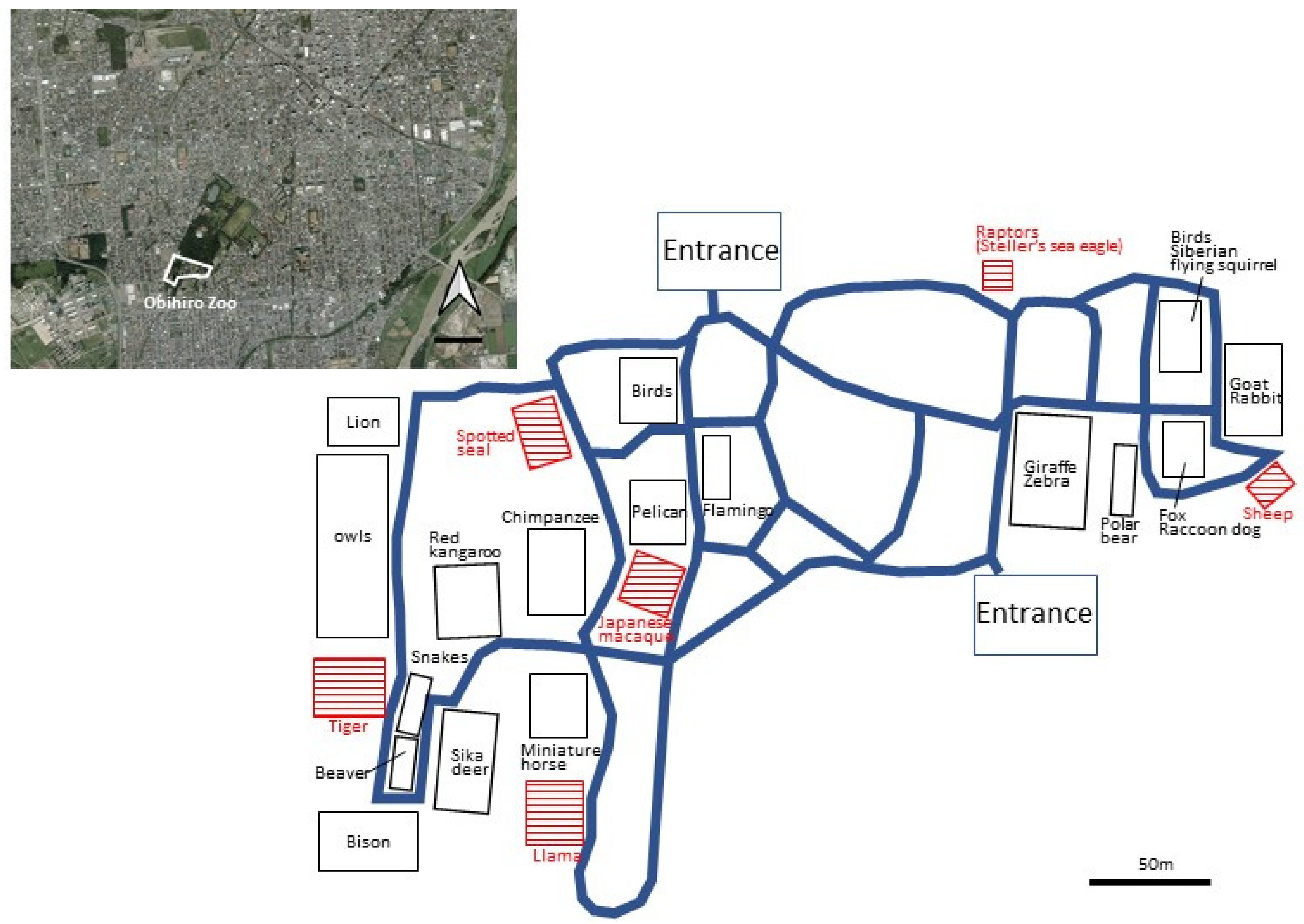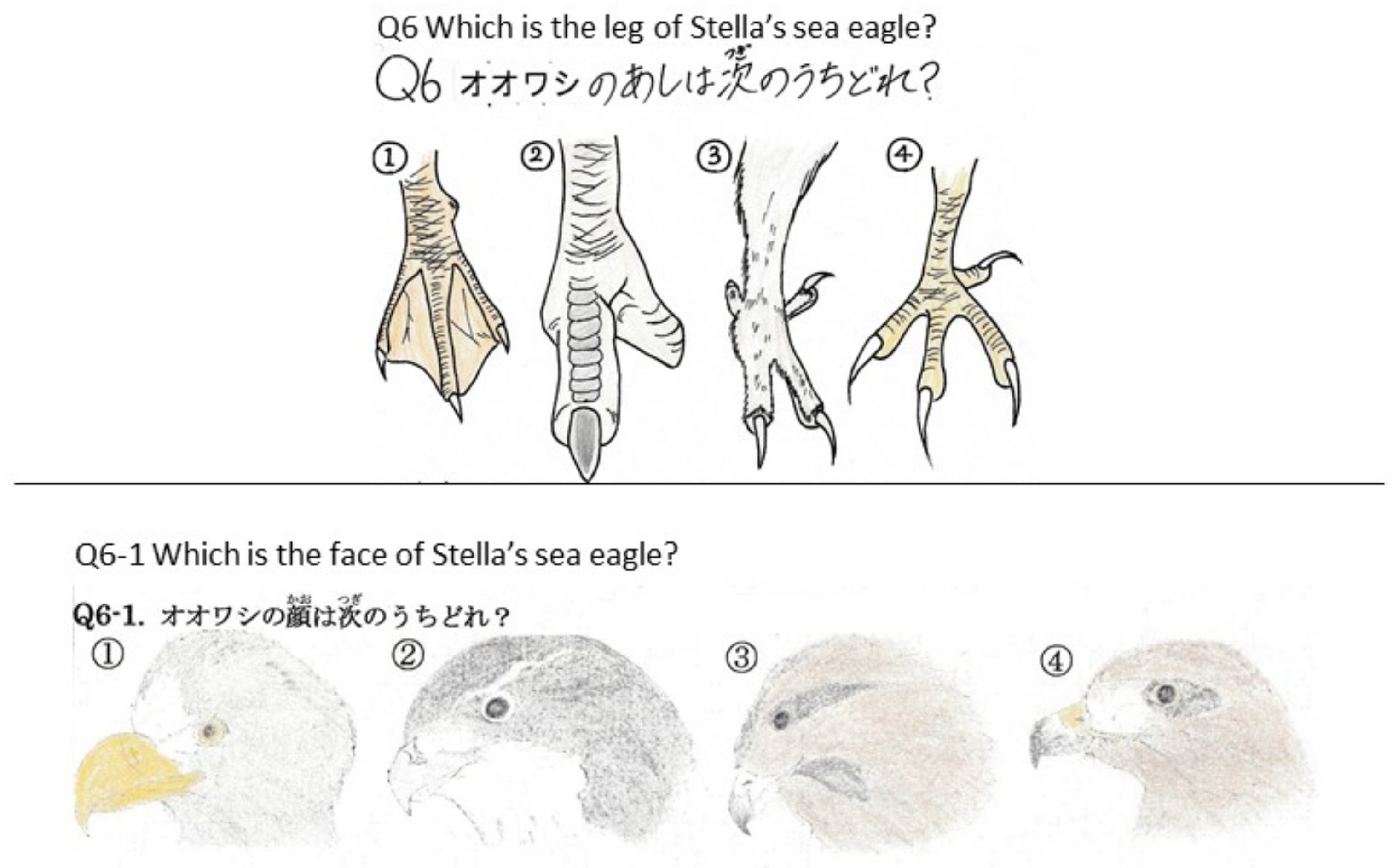Exploring the Impact of Educational Quizzes and Stamp Collecting Trails on Zoo Visitor Learning and Exhibit Observation
Abstract
:1. Introduction
2. Materials and Methods
2.1. Design of Stamps and Questions for Quiz Games
2.2. Evaluation of Animal Observation and Perception of Information Boards
2.3. Statistical Analysis
3. Results
3.1. Sampling Size
3.2. Animal Observation
3.2.1. Effectiveness of Guidance to Animals
3.2.2. Observational Effectiveness
3.2.3. Percentage of Questions Answered Correctly
3.3. Perception of the Information Boards of Target Species
3.3.1. Effectiveness of Perception
3.3.2. Effectiveness of Reading Information Boards
4. Discussion
4.1. Effectiveness of Induction to Target Species
4.2. Observational Effectiveness
4.3. Questions Answered Correctly
4.4. Effectiveness of Perception and Reading of Information Boards
5. Conclusions
Author Contributions
Funding
Institutional Review Board Statement
Informed Consent Statement
Data Availability Statement
Acknowledgments
Conflicts of Interest
References
- Kreger, D.M.; Mench, A.J. Visitor–animal interactions at the zoo. Anthrozoös 1995, 8, 143–158. [Google Scholar] [CrossRef]
- Bitgood, S. Environmental psychology in museums, zoos, and other exhibition centers. In Handbook of Environmental Psychology; Bechtel, R., Churchman, A., Eds.; John Wiley and Sons: Hoboken, NJ, USA, 2002; pp. 461–480. [Google Scholar]
- Andersen, L.L. Zoo education: From formal school programmes to exhibit design and interpretation. Int. Zoo Yearb. 2003, 38, 75–81. [Google Scholar] [CrossRef]
- Ward, I.P.; Mosberger, N.; Kistler, C.; Fischer, O. The relationship between popularity and body size in zoo animals. Conserv. Biol. 1998, 12, 1408–1411. [Google Scholar] [CrossRef]
- Margulis, W.S.; Hoyos, C.; Anderson, M. Effect of felid activity on zoo visitor interest. Zoo Biol. 2003, 22, 587–599. [Google Scholar] [CrossRef]
- Puan, L.C.; Zakaria, M. Perception of visitors towards the role of zoos: A Malaysian perspective. Int. Zoo Yearb. 2007, 41, 226–232. [Google Scholar] [CrossRef]
- Moss, A.; Esson, M. Visitor interest in zoo animals and the implications for collection planning and zoo education programmes. Zoo Biol. 2010, 29, 715–731. [Google Scholar] [CrossRef] [PubMed]
- Carr, N. An analysis of zoo visitors’ favorite and least favorite animals. Tour. Manag. Perspect. 2016, 20, 70–76. [Google Scholar] [CrossRef]
- Carr, N. Ideal animals and animal traits for zoos: General public perspectives. Tour. Manag. 2016, 57, 37–44. [Google Scholar] [CrossRef]
- Sellinger, R.L.; Ha, J.C. The effects of visitor density and intensity on the behavior of two captive jaguars (Panthera onca). J. Appl. Anim. 2005, 8, 233–244. [Google Scholar] [CrossRef]
- Davey, G. Relationships between exhibit naturalism animal visibility and visitor interest in a Chinese zoo. J. Appl. Anim. Behav. Sci. 2006, 96, 93–102. [Google Scholar] [CrossRef]
- Godinez, A.; Fernandez, E.J.; Morrissey, K. Visitor behaviors and perceptions of jaguar activities. Anthrozoös 2013, 26, 613–619. [Google Scholar] [CrossRef]
- Clayton, S.; Fraster, J.; Saunders, D.C. Zoo experiences: Conversations, connections, and concern for animals. Zoo Biol. 2009, 28, 377–397. [Google Scholar] [CrossRef] [PubMed]
- Reade, S.L.; Waran, K.N. The modem zoo: How do people perceive zoo animals? Appl. Anim. Behav. Sci. 1996, 47, 109–118. [Google Scholar] [CrossRef]
- Lee, H.-S. Measurement of visitors’ satisfaction with public zoos in Korea using importance-performance analysis. Tour. Manag. 2015, 47, 251–260. [Google Scholar] [CrossRef]
- Patric, G.P.; Mattews, E.C.; Ayers, F.D. Conservation and education: Prominent themes in zoo mission statements. J. Environ. Educ. 2007, 38, 53–60. [Google Scholar] [CrossRef]
- Fernandez, J.E.; Tamborski, A.M.; Pickens, R.S.; Timberlake, W. Animal–visitor interactions in the modern zoo: Conflicts and interventions. Appl. Anim. Behav. Sci. 2009, 120, 1–8. [Google Scholar] [CrossRef]
- Luebke, J.F.; Watters, J.V.; Packer, J.; Miller, L.J.; Powell, D.M. Zoo visitors’ affective responses to observing animal behavior. Visit. Stud. 2016, 19, 60–76. [Google Scholar] [CrossRef]
- Jensen, E. Evaluating children’s conservation biology learning at the Zoo. Conserv. Biol. 2014, 28, 1004–1011. [Google Scholar] [CrossRef] [Green Version]
- Abe, M.; Hasegawa, N.; Koba, K.; Moriya, K.; Sakai, T. Development and evaluation of information providing system using PDA and GPS for nature observation. Jpn. J. Educ. Technol. 2004, 28, 39–47. (In Japanese) [Google Scholar]
- Katayama, T.; Murao, K.; Tanaka, K.; Terada, T.; Nishio, S. Construction of a navigation system with a route planning algorithm using body-worn sensors. IPSJ J. 2009, 50, 2350–2359. (In Japanese) [Google Scholar]
- Ogino, T.; Hatono, I.; Ifuku, K.; Suzuki, M.; Kusumoto, F. Animal observation support system with the use of GPS cellular phones for general visitors in a zoo. IPSJ SIG Tech. Rep. 2009, 26, 71–77. (In Japanese) [Google Scholar]
- Lindemann-Matthies, P.; Kamer, T. The influence of an interactive educational approach on visitors’ learning in a Swiss Zoo. Sci. Educ. 2005, 90, 296–315. [Google Scholar] [CrossRef]
- Counsell, G.; Moon, A.; Littlehales, C.; Brooks, H.; Bridges, E.; Moss, A. Evaluating an in-school zoo education programme: An analysis of attitudes and learning. J. Zoo Aquar. Res. 2020, 8, 99–106. [Google Scholar]
- R Development Core Team. R: A Language and Environment for Statistical Computing; R Foundation for Statistical Computing: Vienna, Austria, 2019; Available online: https://www.R-project.org/ (accessed on 1 March 2019).
- East, D.; Osborne, P.; Kemp, S.; Woodfine, T. Combining GPS & survey data improves understanding of visitor behavior. Tour. Manag. 2017, 61, 307–320. [Google Scholar]
- Colléony, A.; Clayton, S.; Couvet, D.; Jalme, M.S.; Prévot, A.-C. Humanity preferences for species conservation: Animal charisma trumps endangered status. Biol. Conserv. 2017, 206, 263–269. [Google Scholar] [CrossRef] [Green Version]
- Kimble, G. Children learning about biodiversity at an environment centre, a museum and at live animal shows. Stud. Educ. Eval. 2014, 41, 48–57. [Google Scholar] [CrossRef]
- Pearson, E.; Dorrian, J.; Litchfield, C.A. Measuring zoo visitor learning and understanding about orangutans: Evaluation to enhance learning outcomes and to foster conservation action. Environ. Educ. Res. 2013, 19, 823–843. [Google Scholar] [CrossRef]



| Categories | Number of Visitors | Spotted Seal | Japanese Macaque | Tiger | Sheep | Llama | Steller’s Eagle |
|---|---|---|---|---|---|---|---|
| Control | Total Animal observation | 307 252 | 307 278 | 307 242 | 307 199 | 307 139 | 307 183 |
| Stamp collecting | Total Animal observation | 294 289 | 294 285 | 294 287 | 294 269 | 294 276 | 294 271 |
| Quiz game | Total Animal observation | 309 299 | 309 298 | 309 294 | 309 290 | 309 283 | 309 289 |
| Categories | Visitor’s Behavior | Spotted Seal | Japanese Macaque | Tiger | Sheep | Llama | Steller’s Eagle |
|---|---|---|---|---|---|---|---|
| Control | Number of correct answerers | 66.7% (252) | 42.0% (276) | 10.0% (240) | 39.7% (199) | 26.6% (139) | 67.2% (180) |
| without stopping | 29 | 24 | 6 | 31 | 14 | 33 | |
| with stopping | 139 | 92 | 18 | 48 | 23 | 88 | |
| Stamp collecting | Number of correct answerers | 76.5% (281) | 48.9% (282) | 9.5% (285) | 45.1% (266) | 29.3% (276) | 57.2% (271) |
| without stopping | 42 | 40 | 2 | 43 | 15 | 44 | |
| with stopping | 173 | 98 | 25 | 77 | 66 | 111 | |
| Quiz game | Number of correct answerers | 75.1% (293) | 53.6% (293) | 8.3% (289) | 40.5% (284) | 24.9% (277) | 57.9% (285) |
| without stopping | 28 | 27 | 3 | 18 | 14 | 27 | |
| with stopping | 192 | 130 | 21 | 97 | 55 | 138 |
| Categories | Visitor’s Behavior | Spotted Seal | Japanese Macaque | Tiger | Sheep | Llama | Steller’s Eagle |
|---|---|---|---|---|---|---|---|
| Control | Visitor’s noticed information board | 80.6% (248) | 71.6% (271) | 79.8% (238) | 65.3% (196) | 83.9% (137) | 78.7% (178) |
| Read information board | 52.0% (200) | 41.2% (80) | 50.0% (95) | 34.4% (44) | 66.1% (76) | 60.7% (85) | |
| Stamp collecting | Visitor’s noticed information board | 86.8% (287) | 78.5% (284) | 87.5% (287) | 80.2% (268) | 85.4% (274) | 82.7% (271) |
| Read information board | 56.2% (140) | 42.2% (94) | 55.4% (139) | 43.7% (94) | 62.4% (146) | 54.5% (122) | |
| Quiz game | Visitor’s noticed information board | 90.9% (296) | 86.7% (294) | 93.1% (289) | 88.4% (284) | 90.0% (279) | 91.3% (288) |
| Read information board | 69.9% (188) | 51.0% (130) | 59.5% (160) | 54.2% (136) | 59.8% (150) | 63.5% (167) |
Publisher’s Note: MDPI stays neutral with regard to jurisdictional claims in published maps and institutional affiliations. |
© 2021 by the authors. Licensee MDPI, Basel, Switzerland. This article is an open access article distributed under the terms and conditions of the Creative Commons Attribution (CC BY) license (https://creativecommons.org/licenses/by/4.0/).
Share and Cite
Asari, Y.; Ikuta, C. Exploring the Impact of Educational Quizzes and Stamp Collecting Trails on Zoo Visitor Learning and Exhibit Observation. J. Zool. Bot. Gard. 2021, 2, 445-452. https://doi.org/10.3390/jzbg2030032
Asari Y, Ikuta C. Exploring the Impact of Educational Quizzes and Stamp Collecting Trails on Zoo Visitor Learning and Exhibit Observation. Journal of Zoological and Botanical Gardens. 2021; 2(3):445-452. https://doi.org/10.3390/jzbg2030032
Chicago/Turabian StyleAsari, Yushin, and Chiharu Ikuta. 2021. "Exploring the Impact of Educational Quizzes and Stamp Collecting Trails on Zoo Visitor Learning and Exhibit Observation" Journal of Zoological and Botanical Gardens 2, no. 3: 445-452. https://doi.org/10.3390/jzbg2030032
APA StyleAsari, Y., & Ikuta, C. (2021). Exploring the Impact of Educational Quizzes and Stamp Collecting Trails on Zoo Visitor Learning and Exhibit Observation. Journal of Zoological and Botanical Gardens, 2(3), 445-452. https://doi.org/10.3390/jzbg2030032






